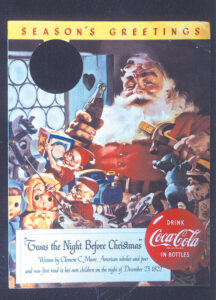 By Henry J. Pratt
By Henry J. Pratt Young children to adults in their golden years know all about that legendary HO-HO-HO bringer of Christmas gifts—Santa Claus.
Though he’s almost totally an American creation, Santa’s roots come from many countries and go back far in time. Santa is now a universal character, loved by men, women and children the world over.
His name is derived from the U. S. colonial adaptation of the Dutch Sinter Claes and Sante Klaus. In some other nations, Santa is known as Father Christmas, St. Nick, Pelz Nichol and Pere Noel. Historians say that St. Nicholas—patron saint of children and sailors, as well as Russia and Greece—was a real person, who lived in the 4th century.
When only a boy, St. Nicholas was made bishop of Myra, located in Lycia, Asia Minor, which today is in Turkey. He was wealthy and secretly helped the poor. For years, someone representing the saint dressed in a bishop’s robes and rode through the streets on a white donkey, distributing gifts to small children.
In Holland, children put their shoes out to receive the gifts. In Germany and elsewhere, children hang up their stockings and sometimes leave fresh cookies and milk for Santa’s arrival. Santa rides a horse in some countries, but in others he comes by cart or a sleigh drawn by reindeer.
Dutch settlers brought their old custom of St. Nicholas Day with them to New Amsterdam, which now is New York City. The American author, Washington Irving, popularized him as Santa Claus in his Knickerbocker History of New York (1809).
Instead of being a tall, thin saint, Santa—according to author Irving—was a fat and jolly old elf, a friendly guy with a long, white beard, and dressed in red and white clothes. Clement C. Moore’s familiar poem for children, known better as “The Night Before Christmas,” was written in 1822. Everyone knows, in that poem, that the Americanized Santa Claus rides in a toy-packed sleigh pulled over the rooftops by eight tiny reindeer. Santa descends into our homes through the chimney, and he has become fatter and more jovial than ever.
Long depicted in life and legend as a WASP (White, Anglo-Saxon Protestant), Santa turned up in a widely-publicized incident in a California city in 1990 as dark-skinned in a red-and-white suit. For many minority families and others, this was a long time coming. Surely, we ought to soon have children sitting on the knees of Santas who are Hispanics, Native Americans, Jews and Asians, as well as African-Americans.
The spirit of kindness and love for others burned brightly in the life of America’s “first” Santa. A few weeks before Christmas in 1890, he made his debut at the Boston Store in Brockton, Massachusetts. Our first department-store Santa ever turned out to be the popular store owner, James Edgar, who wore his Christmas costume to delight the children coming to the store with their parents. James Edgar, a native of Scotland who came to America as a child, made boys and girls more aware of Santa Claus than they’d ever been before. They had seen sketches of Santa in magazines and newspapers. But their new Santa in the flesh was a tall, well-stuffed soul with a ruddy complexion. Edgar had a rich, warm and friendly voice and a snowy, white beard.
The next day after Santa first appeared, Edgar’s store was crowded with children. All the kids in town, it seemed, came down to see their great roly-poly hero—such a nice old man with toys on his back to open up on Christmas morning. Word of Edgar’s great success playing Santa Claus spread fast across the nation.
In 1891, Santa made his debut at several other major stores across the country. Ten years later, Santa had knee thrones for kids and grandkids in department stores in nearly every city in America.
Only a relatively few children had a chance to meet Santa when James Edgar first came up with the best idea he ever had. This year, millions of eager young children will whisper their Christmas wants in Santa’s ear and say, “Please come to my house on Christmas Eve.” Yes, Virginia, and all you other kids around the world, there is, indeed, a Santa Claus.















Follow Us